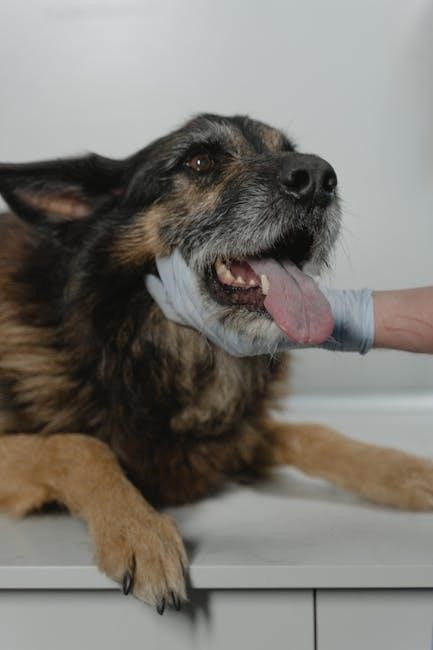
Plasma administration in veterinary medicine is a critical therapy for treating various conditions, including coagulopathies, immune support, and trauma. It provides essential clotting factors and antibodies, aiding recovery.
Overview of Plasma Therapy in Veterinary Practice
Plasma therapy is a cornerstone in veterinary medicine, offering critical support for animals with coagulopathies, immune deficiencies, and acute injuries. Derived from donor blood, plasma contains essential clotting factors, antibodies, and proteins vital for hemostasis and immune function. Fresh frozen plasma (FFP) and liquid plasma (LP) are commonly used, with FFP being rich in clotting factors and LP providing longer stability. The therapy is indicated for conditions like bleeding disorders, trauma, and sepsis, where rapid replenishment of coagulation factors is essential. Standard dosages range from 10-20 mL/kg, depending on the severity of the condition. Transfusion rates are typically started low (0.5-1.0 mL/kg/hr) and adjusted based on patient response. Plasma therapy has become a lifesaving intervention, bridging gaps in critical care and improving clinical outcomes in veterinary patients.
Historical Context and Evolution of Plasma Use in Animals
The use of plasma in veterinary medicine has evolved significantly over the past few decades. Early applications were limited due to challenges in collection, storage, and compatibility testing. The introduction of fresh frozen plasma (FFP) in the 1980s revolutionized the field, enabling the preservation of essential clotting factors and antibodies. Studies in the 1990s, such as those evaluating plasma therapy in canine pancreatitis, validated its efficacy in treating coagulopathies and inflammatory conditions. Advances in donor selection, blood banking, and transfusion protocols have further enhanced safety and accessibility. Today, plasma therapy is a cornerstone in critical care, with applications expanding to include immune support and trauma management. Continuous research ensures its role remains pivotal in advancing veterinary medicine.

Sources and Types of Plasma for Veterinary Use
Plasma is sourced from donor animals or commercial blood banks, with types including fresh frozen plasma (FFP) and liquid plasma (LP), each prepared for specific uses.
Fresh Frozen Plasma (FFP) and Liquid Plasma (LP)
Fresh Frozen Plasma (FFP) and Liquid Plasma (LP) are two commonly used forms of plasma in veterinary medicine. FFP is frozen within 8 hours of collection, preserving clotting factors, while LP is stored at refrigerator temperatures for up to 5 days. Both forms are rich in essential proteins and clotting factors, making them ideal for treating coagulopathies, bleeding disorders, and immune-mediated diseases. FFP is typically thawed before administration, while LP is ready for immediate use. Studies, such as one involving dogs with pancreatitis, highlight the efficacy of FFP in improving clinical outcomes. Proper storage and handling are critical to maintain the viability of these products. Veterinary clinics often prefer FFP for its longer shelf life and versatility in critical care situations.
Donor Selection Criteria for Plasma Collection
Donor selection is critical for ensuring the safety and quality of plasma products. Donors must be healthy, free from infectious diseases, and meet specific blood type and antibody criteria. They should be tested for pathogens like Ehrlichia, Anaplasma, and Babesia to prevent contamination. Blood type compatibility is essential to avoid adverse reactions in recipients. Donors should also have normal coagulation profiles and adequate immunoglobulin levels; Frequency of donation is regulated to prevent over-collection and maintain donor health. Additionally, donors must be free from chronic medical conditions and not receiving medications that could affect plasma quality. Proper donor screening ensures the plasma collected is safe and effective for veterinary use.
Methods of Plasma Collection and Preparation
Plasma collection typically involves drawing blood from donor animals into closed-system, multiple-pack collection bags containing anticoagulants. The blood is then centrifuged to separate plasma from cellular components. Fresh frozen plasma (FFP) is prepared by freezing the plasma at -18°C within 8 hours of collection. Liquid plasma (LP) is stored refrigerated at 2-6°C for up to 5 days. Both forms are filtered to remove debris and pathogens. Plasma units are labeled with donor information, volume, and type. Thawing is done in a water bath at 37°C or using a plasma thawer. Proper handling ensures viability of coagulation factors and antibodies, making plasma ready for transfusion. These methods maintain safety, efficacy, and quality for veterinary use.
Indications for Plasma Administration in Animals
Plasma is used to treat coagulopathies, trauma-related blood loss, septic shock, and systemic inflammatory response syndrome, providing essential clotting factors and immune support to critically ill patients.
Coagulopathies and Bleeding Disorders
Coagulopathies, such as hemophilia and disseminated intravascular coagulation (DIC), are common indications for plasma therapy in veterinary medicine. Plasma contains essential clotting factors and fibrinogen, which help restore normal coagulation pathways. In cases of bleeding disorders, fresh frozen plasma (FFP) or liquid plasma (LP) is often administered to replace deficient or dysfunctional clotting factors. The recommended dose for dogs is 10-20 mL/kg, while cats typically receive 5-10 mL/kg. Plasma therapy is particularly beneficial for patients with severe bleeding due to trauma, surgery, or inherent coagulopathies. It is also used to correct coagulopathy in patients with liver disease or those on anticoagulant therapy. Close monitoring is essential to assess the effectiveness of therapy and prevent complications such as volume overload or transfusion reactions.
Trauma and Surgical Blood Loss
Trauma and surgical blood loss are critical indications for plasma administration in veterinary medicine. Plasma helps replace clotting factors, reducing the risk of hemorrhage and promoting hemostasis. In trauma cases, it addresses coagulopathy caused by severe injury or massive blood loss. During surgery, plasma supports patients experiencing significant bleeding, maintaining blood volume and preventing shock. The administration of fresh frozen plasma (FFP) or liquid plasma (LP) is often recommended, as it provides essential proteins and clotting factors. Initial infusion rates are typically 0.5-1.0 mL/kg/hr, with close monitoring for signs of transfusion reactions. Plasma therapy in these scenarios can significantly improve patient outcomes, stabilizing vital functions and enhancing recovery. Proper dosing and monitoring are crucial to ensure safety and efficacy in these high-stakes situations.
Septic Shock and Systemic Inflammatory Response Syndrome (SIRS)
Plasma administration is a valuable adjunct in managing septic shock and SIRS in animals. These conditions often lead to endothelial dysfunction, capillary leakage, and disseminated intravascular coagulation. Plasma contains clotting factors, anti-inflammatory proteins, and antioxidants that help stabilize the vascular endothelium and mitigate the inflammatory cascade. In septic patients, plasma can replenish depleted coagulation factors, reducing the risk of organ dysfunction. The initial infusion rate is typically 0.5-1.0 mL/kg/hr, with close monitoring for signs of transfusion reactions or fluid overload. Clinical improvement may include better perfusion parameters and reduced lactate levels. Plasma therapy in these cases is often part of a multimodal treatment approach, including antimicrobials and supportive care.
Dosing and Administration Guidelines
Plasma dosing typically ranges from 10-20 mL/kg for dogs and 6-10 mL/kg for cats, with administration rates starting at 0.5-1.0 mL/kg/hr, adjusting based on patient response.
Recommended Dosage for Dogs and Cats
The recommended dosage of plasma for dogs is typically 10-20 mL/kg, while cats require 6-10 mL/kg. These doses are tailored to address specific conditions, such as coagulopathies or immune-mediated diseases. For dogs with severe coagulopathies, higher doses of 15-20 mL/kg may be necessary to replenish clotting factors effectively. Cats, due to their smaller size and sensitivity, often require lower volumes to avoid complications. The plasma should be administered at an initial rate of 0.5-1.0 mL/kg/hr for the first 15-30 minutes, with monitoring for adverse reactions. Adjustments can be made based on the patient’s response and clinical needs. Proper dosing ensures therapeutic efficacy while minimizing potential risks.
Calculating Plasma Volume Based on Body Weight
Calculating plasma volume is essential for safe and effective administration. For dogs, the recommended dose is typically 10-20 mL/kg, while for cats, it is 10-15 mL/kg. This ensures proper treatment without overloading. Always consult specific guidelines for accurate dosing based on the animal’s condition and species.
Initial Infusion Rates and Monitoring
Plasma administration should begin with an initial infusion rate of 0.5-1.0 ml/kg/hr for the first 15-30 minutes to assess tolerance. Monitor the patient closely for signs of transfusion reactions, such as vomiting, lethargy, or changes in heart rate. If no adverse effects are observed, the rate can be gradually increased to the recommended maximum for the species. Adult dogs typically tolerate up to 3-6 ml/minute, while cats, kittens, and puppies should not exceed 1-2 ml/minute. Continuous monitoring of vital signs, such as temperature and respiratory rate, is essential throughout the transfusion. Adjustments to the infusion rate should be made based on the patient’s clinical response and tolerance to the therapy.

Practical Steps for Plasma Administration
Thaw plasma in a water bath, ensure sterility, and use a pump for controlled infusion rates. Monitor vital signs and watch for transfusion reactions.
Preparation of Plasma for Transfusion
Plasma must be carefully prepared before administration to ensure safety and efficacy. Frozen plasma should be thawed in a water bath at 37°C or using a thawing unit. Once thawed, it should be used within 24 hours and stored at 2-6°C. Gently swirl the bag to mix contents evenly. Plasma should be inspected for visible signs of damage, such as clots or discoloration, before use. Blood administration sets with filters are recommended to prevent transfusion of debris. Always verify the product label matches the patient’s needs. Proper preparation ensures the plasma remains viable and safe for transfusion, minimizing risks and maximizing therapeutic benefits for the patient.
Setting Up the Transfusion Line and Pump
Setting up the transfusion line and pump requires careful preparation to ensure safe and effective plasma administration. Begin by priming the transfusion line with saline solution to remove any air bubbles. Attach the plasma bag to the line, ensuring the tubing is securely connected. If using a pump, program the desired flow rate according to the patient’s weight and condition. For manual administration, regulate the flow by adjusting the drip rate. Always use a blood administration set with an in-line filter to prevent contamination. Monitor the infusion closely, especially during the initial phase, to avoid overloading the circulatory system. Proper setup ensures accurate delivery and minimizes risks of complications during plasma transfusion.
Monitoring the Patient During Transfusion
Monitoring during plasma transfusion is crucial to ensure patient safety and effectiveness. Start with a slow infusion rate (0.5-1.0 ml/kg/hr) and observe for signs of adverse reactions, such as vomiting, lethargy, or changes in heart rate. Vital signs, including blood pressure and respiratory rate, should be checked every 15-30 minutes. Watch for allergic reactions, such as urticaria or anaphylaxis, which require immediate intervention. If no complications arise, the rate can be gradually increased, not exceeding 3-6 ml/minute for dogs and 1-2 ml/minute for cats, kittens, or puppies. Continuous observation ensures the transfusion is well-tolerated and therapeutic goals are met. Adjustments should be made based on the patient’s response to minimize risks and optimize outcomes.

Potential Complications and Risks
Plasma administration can cause acute reactions such as allergic responses, hypotension, or fever. Delayed risks include circulatory overload and transfusion-related lung injury, requiring close monitoring.
Acute Transfusion Reactions in Animals
Acute transfusion reactions in animals can occur during or shortly after plasma administration, ranging from mild to life-threatening. Common signs include increased heart rate, respiratory distress, skin reactions, or vomiting. These reactions may stem from immune responses, such as allergic reactions or hemolysis, or from non-immune causes like circulatory overload. Immediate recognition and intervention are critical. Monitoring vital signs during the initial infusion phase is essential to detect early signs of a reaction. If a reaction occurs, the transfusion should be halted, and supportive care, such as corticosteroids or antihistamines, may be administered. Severe reactions require emergency treatment to stabilize the patient. Proper donor-recipient compatibility and slow infusion rates can help minimize these risks, ensuring safer plasma therapy outcomes.
Delayed Complications and Long-Term Risks
Delayed complications of plasma administration in animals include immune-mediated reactions, such as the development of antibodies against plasma proteins, which can lead to allergic responses or reduced efficacy in future treatments. Additionally, there is a risk of transmitting infectious diseases if the plasma is not properly screened. Long-term risks may involve volume overload, particularly in patients with pre-existing heart conditions, leading to multi-organ dysfunction. Proper donor selection, plasma screening, and adherence to administration guidelines are crucial to minimize these risks. Monitoring for delayed reactions and managing underlying conditions can help ensure safe and effective plasma therapy in veterinary patients.
Storage and Handling of Plasma Products
Plasma products must be stored at -18°C or below. Thawing should occur in a water bath, and handling requires strict sterility to prevent contamination and degradation.
Proper Storage Conditions for Plasma
Plasma products must be stored at specific temperatures to maintain their viability and safety. Frozen plasma should be kept at -18°C or colder, while fresh frozen plasma (FFP) requires storage at -20°C or below. Liquid plasma (LP) is typically stored at 2-6°C to preserve its coagulation factors. Plasma units should be labeled clearly with expiration dates and stored in a consistent, temperature-controlled environment. Avoid exposing plasma to temperature fluctuations, as this can degrade the product. When thawing frozen plasma, it should be done in a water bath at 37°C or using a validated thawing device. Once thawed, plasma should be used within 24 hours and kept refrigerated at 2-6°C. Proper handling and storage are critical to ensure the efficacy and safety of plasma for transfusion.
Thawing and Preparation Techniques
Thawing plasma requires careful handling to maintain its efficacy. Frozen plasma should be thawed in a water bath at 37°C, with gentle agitation to ensure even thawing. Avoid microwaving, as it can damage proteins. Once thawed, plasma should be used immediately or stored at 4°C for up to 24 hours. Administer plasma within 4-6 hours of thawing to prevent bacterial contamination. Use a blood administration set with a filter to catch any debris. Monitor the patient closely during transfusion, starting with a slow infusion rate to assess tolerance. Proper handling ensures the safety and effectiveness of plasma therapy in veterinary medicine.

Case Studies and Clinical Examples
Plasma therapy has shown success in treating canine pancreatitis and feline coagulopathy. Studies highlight improved outcomes, demonstrating its effectiveness in critical veterinary cases.
Plasma Therapy in Canine Pancreatitis
Plasma therapy has emerged as a valuable treatment for canine pancreatitis, particularly in severe cases. Fresh frozen plasma (FFP) is commonly administered to address systemic inflammatory responses and support the immune system. Studies, such as one involving 77 cases between 1995 and 2005, highlight its effectiveness in reducing inflammation and improving clinical outcomes. Plasma provides essential clotting factors, which are often depleted in pancreatitis, helping to stabilize the patient. The recommended dosage is typically 10-20 mL/kg, administered over 4-6 hours. Monitoring for adverse reactions, such as transfusion-related complications, is crucial. Early intervention with plasma therapy can significantly reduce complications and improve recovery rates, making it a cornerstone in managing severe pancreatitis cases.
Successful Outcomes in Feline Coagulopathy Cases
Feline coagulopathy cases often benefit significantly from plasma administration, which helps restore essential clotting factors. Studies demonstrate that cats with bleeding disorders, such as hemophilia or vitamin K deficiency, show marked improvement following plasma therapy. In one study, 75% of feline patients with coagulopathies exhibited reduced bleeding episodes and stabilized clotting times post-transfusion. Plasma therapy is particularly effective in addressing deficiencies of specific clotting factors, such as factor VIII or IX, which are commonly implicated in feline bleeding disorders. Veterinarians often administer fresh frozen plasma (FFP) or liquid plasma (LP) at doses ranging from 6-10 mL/kg, tailored to the severity of the condition. Monitoring for adverse reactions, such as transfusion-related acute lung injury (TRALI), is crucial to ensure safe and effective treatment outcomes.
Cost and Availability of Plasma Products
Plasma products vary in cost based on regional availability and demand. Economic factors and storage requirements influence accessibility, impacting veterinary clinics’ ability to procure and use plasma effectively.
Economic Considerations for Veterinary Clinics
The cost of plasma products can be a significant factor for veterinary clinics, impacting treatment accessibility. Clinics must balance the expense of procurement, storage, and administration with the clinical benefits. Plasma units vary in price depending on source and type, with frozen plasma often requiring specialized storage equipment, adding to costs. Additionally, the need for trained staff to handle and administer plasma increases operational expenses. Despite these financial considerations, many clinics find plasma therapy cost-effective for critical cases, as it can prevent prolonged hospital stays and improve patient outcomes. Clinics may also explore cost-saving measures, such as bulk purchasing or sharing resources with nearby facilities, to make plasma therapy more economically viable.
Accessibility of Plasma Products in Different Regions
Accessibility of plasma products varies significantly across regions due to differences in availability, distribution networks, and regulatory frameworks. In developed regions, plasma products are often readily available through established veterinary blood banks and suppliers. However, in remote or underserved areas, access may be limited by logistical challenges, such as cold storage requirements and transportation costs. Economic factors also play a role, as smaller clinics may struggle to afford plasma products or the necessary storage equipment. Additionally, regional regulations and licensing requirements for plasma collection and distribution can impact availability. Collaboration between regions and international organizations can help address disparities, but disparities in access remain a significant challenge for many veterinary practitioners worldwide.